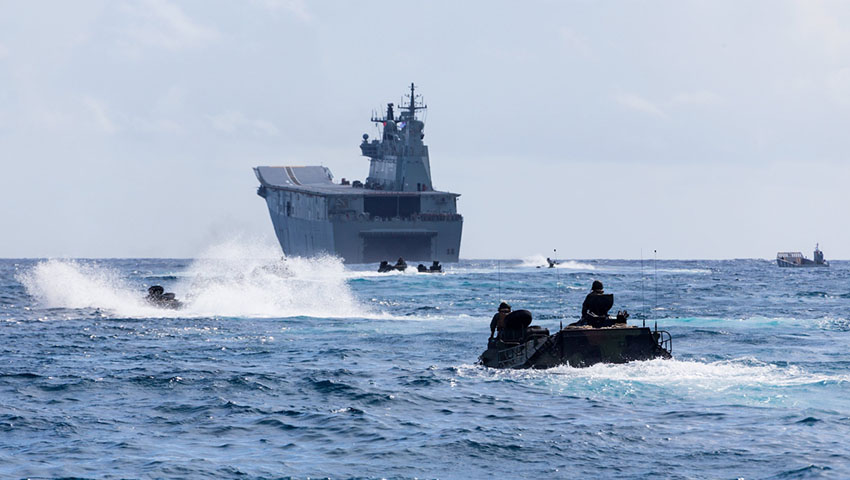A team of Navy engineering and technical experts have provided much-needed maintenance and sustainment support for the Royal Australian Navy’s HMAS Adelaide while the critical capability was training off the east coast.
To continue reading the rest of this article, please log in.
Create free account to get unlimited news articles and more!
The LHD, operating in the vicinity of Jervis Bay, was undergoing a series of test and survey activities when the leak was discovered during engineering rounds. It was a seawater leak coming from a motorised valve on the ballast system.
HMAS Adelaide’s unique amphibious capability was challenged during her recent period at sea as a leak on a seawater pipeline threatened to impact on docking operations.
Due to the size and difficult location of the equipment, a temporary attempt wasn’t successful.
The ship had activities planned for the following days that required docking down, and the decision was made that replacing the valve was the only solution to guarantee Adelaide’s water tight integrity and ability to stay on task.
Chief Petty Officer Marine Technician Robert Cresswell explained, “It would’ve prevented the ship from ballasting, thereby preventing docking down and the launching landing craft.”
Faced with the issue of getting the nearly 70 kilogram valve to the ship, Chief Petty Officer Marine Technician Darren Harkins, a member of HMAS Adelaide’s ship’s company who was ashore at the time, stepped in and picked up the valve and delivered it to Jervis Bay in just a few hours.
Leading Seaman Marine Technician Ronald Turner added, “We’d thought we’d never find a replacement in such a short time.”
With careful considerations of the risks associated with opening up such a large section of sea water pipework, along with mitigations and appropriate isolations, members of the Marine Engineering O2 Work Centre, under the supervision of CPO Cresswell, were able to carry out the replacement – the day before having to undertake dock operations south from Jervis Bay.
HMAS Adelaide carried on with testing and survey activities and follow-on amphibious, refuelling, de-ammunition and training evolutions thanks to the proficient efforts of the Marine Engineering department.
The Royal Australian Navy's HMAS Adelaide (III) is the second Canberra Class amphibious assault ship (LHD), also known as a landing helicopter dock, provides the Australian Defence Force with one of the most capable and sophisticated air-land-sea amphibious deployment systems in the world.
These 27,000-tonne ships are able to land a force of over 1,000 personnel by helicopter and watercraft, along with all their weapons, ammunition, vehicles and stores.
The ships were constructed using the modular approach whereby the ship is divided into modules, which were built and fitted out as discrete units, before being welded together to form the completed ship. This allowed the ship to be built at a number of different sites across the shipyard before being brought together for final joining.
Construction of the hull to the level of the flight deck, including the majority of fitting out was undertaken at Navantia's Ferrol-Fene shipyard in north-west Spain. The hull was then shipped to BAE Systems' Williamstown shipyard in Victoria for the installation of the island structure. The island modules were constructed at a number of sites around Australian before they were moved to Williamstown for final installation on the flight deck.
The ships' roles are to:
- embark, transport and deploy an embarked force (Army in the case of the ADF but could equally be an allied army or marines), along with their equipment and aviation units; and
- carry out/support humanitarian missions.
The first LHD, HMAS Canberra, commissioned on 28 November 2014 and the second ship, HMAS Adelaide, commissioned on 4 December 2015.

 Login
Login







